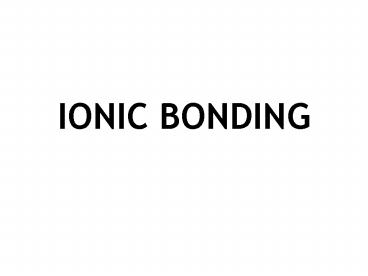IONIC BONDING - PowerPoint PPT Presentation
1 / 16
Title:
IONIC BONDING
Description:
IONIC BONDING Sodium Atom Fluorine Atom Forming the Ionic Bond Summary Sodium Fluoride Let s Try Another One more example Ionic Compounds An ionic ... – PowerPoint PPT presentation
Number of Views:156
Avg rating:3.0/5.0
Title: IONIC BONDING
1
IONIC BONDING
2
Sodium Atom
Atomic Number (Z) 11 Atomic Mass (M)
23 Protons 11 Electrons 11 Neutrons 12
23
Na
11
11 P 12 N
3
Fluorine Atom
Atomic Number (Z) 9 Atomic Mass (M)
19 Protons 9 Electrons 9 Neutrons 19
19
F
9
9 P 10 N
4
Forming the Ionic Bond
Na
F
5
Summary Sodium Fluoride
Na (sodium)
F (fluorine)
loses one electron (P gt E)
gains one electron (P lt E)
Attraction of opposite charges
Na1 (sodium ion)
F1- (fluorine ion)
NaF
6
Lets Try Another
Ca (calcium)
Br (bromine)
loses two electron (P gt E)
gains one electron (P lt E)
Attraction of opposite charges
Ca2 (sodium ion)
F1- (fluorine ion)
7
One more example
Al (aluminum)
S (sulphur)
loses three electrons (P gt E)
gains two electrons (P lt E)
Attraction of opposite charges
Al3 (sodium ion)
S2- (fluorine ion)
8
Ionic Compounds
- An ionic compound generally consists of a metal
and a non-metal - The metal loses electron(s) and becomes a cation
(positively charged ion). - The non-metal gains electron(s) and becomes an
anion (negatively charged ion). - Through the forces of attraction between two
opposite charges, an ionic compound is formed. - There are two types binary (two atoms) and
polyatomic (one atom and one polyatomic ion) - Polyatomic ion is an ion with more than one
atom
9
1
2
3
-3
-2
-1
0
10
COVALENT OR MOLECULAR BONDING
11
Imagine Two Hydrogen Atom
1 P 0 N
1 P 0 N
12
And then they find each other
H
H
And share their electronsTheyre relationship
is so diatomic!
13
Molecular Compounds
- Molecular compounds are composed only of
non-metals - We use binding capacities to understand how
compounds are made - Some molecular compounds are composed of the same
element. These are called diatomic compounds - There are seven diatomic compounds H2,
N2, O2, F2, Cl2, Br2 and I2
14
Binding Capacities- The number of bonds each
atom can make
4
3
2
1
0
15
In Grade 9, you learned the Ball-and-Hook Method
16
Comparing Ionic and Covalent
IONIC COVALENT
Metal and non-metal involved Two non-metals involved
Transferring of electrons Sharing of electrons
Charges involved Binding capacities involved
Naming Metal ide or polyatomic ion Naming Use of prefixes (mono, di, tri, etc.)































